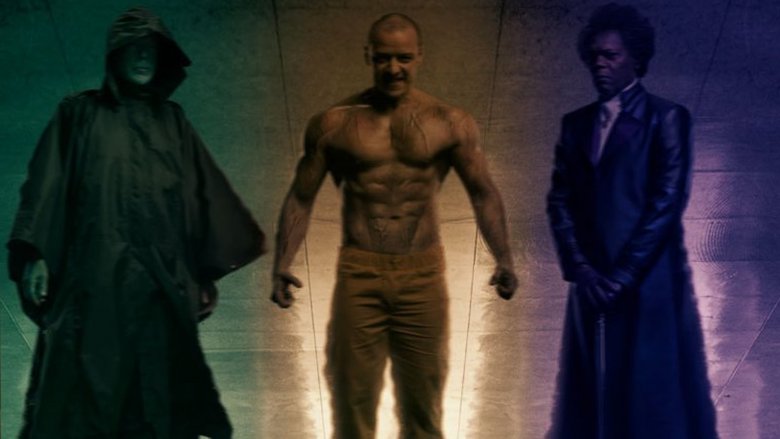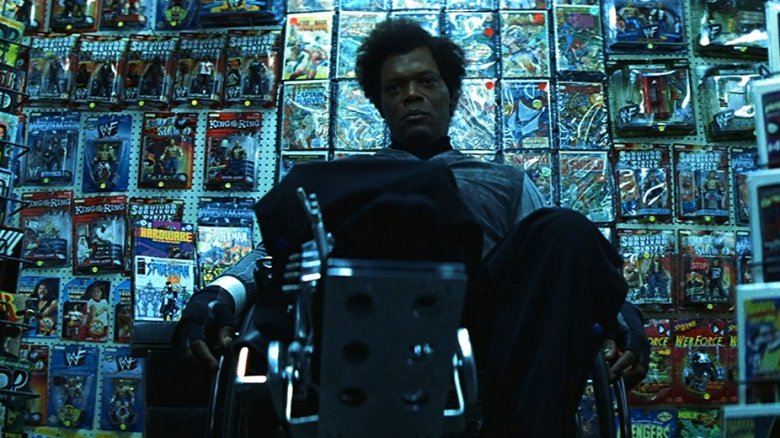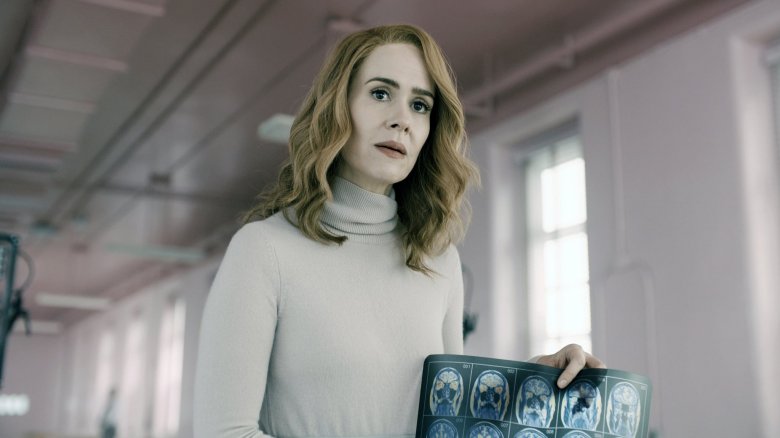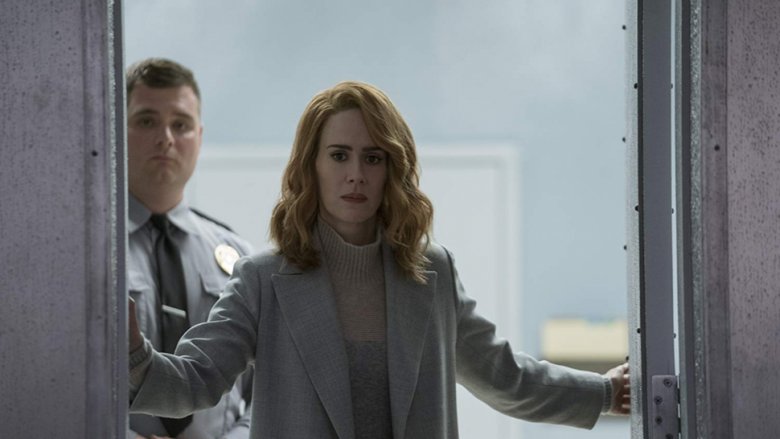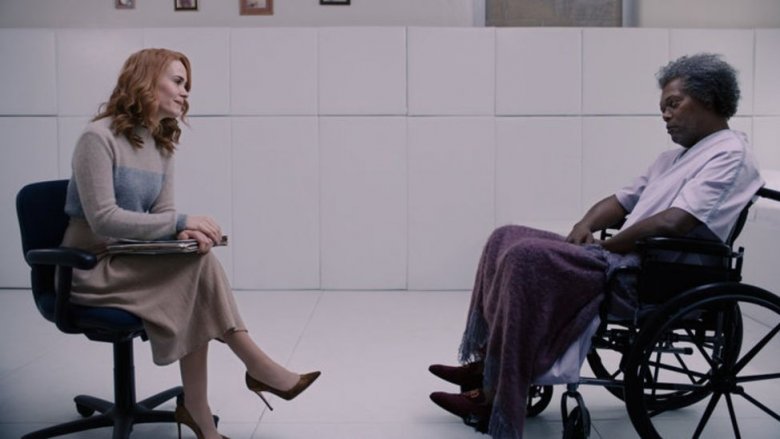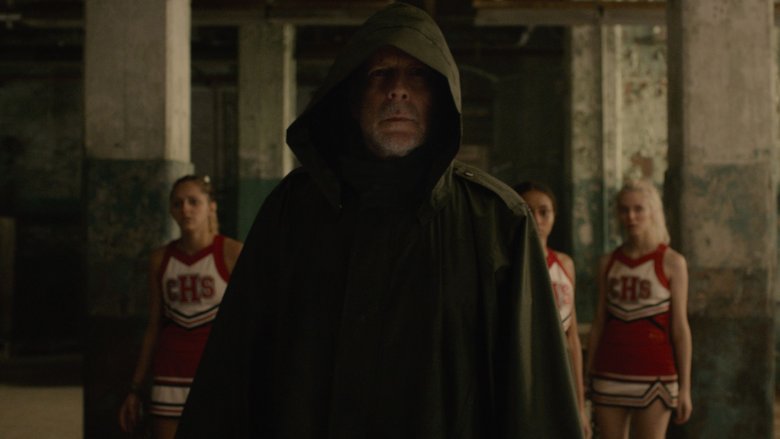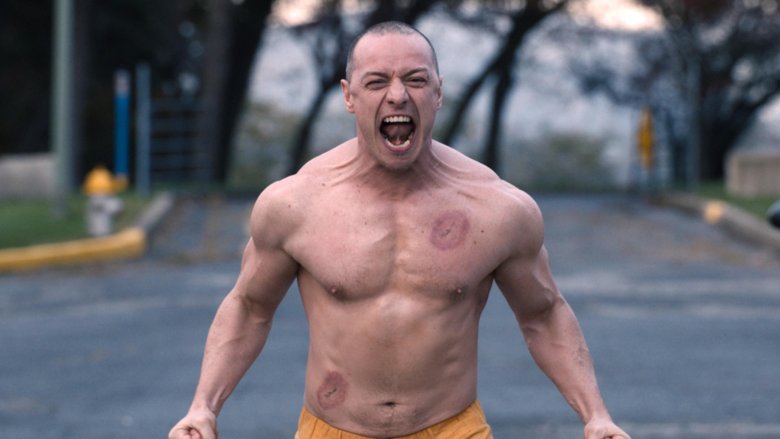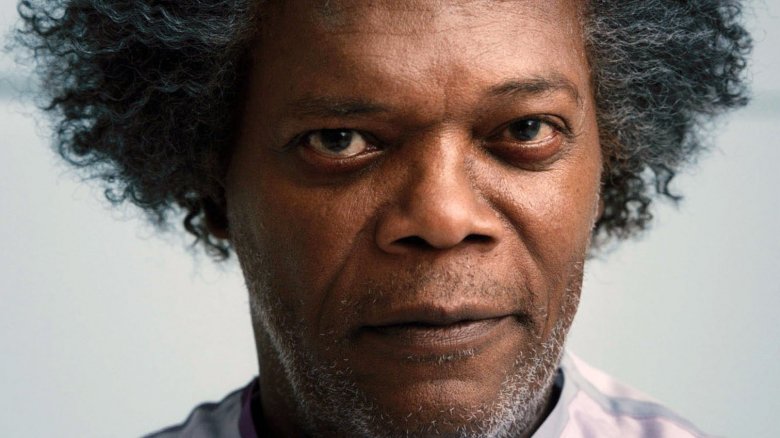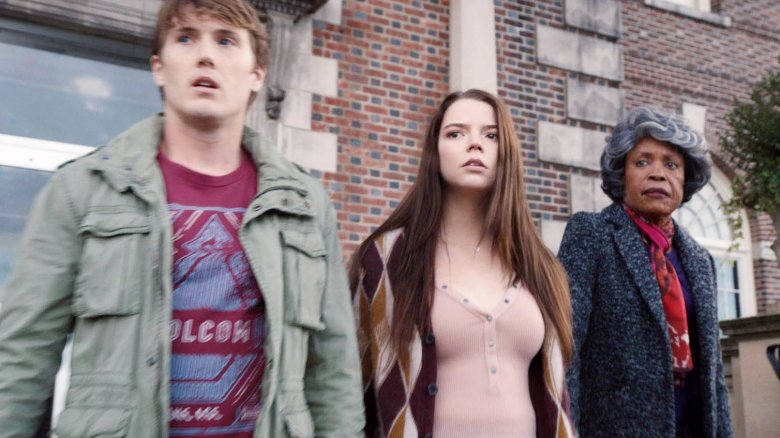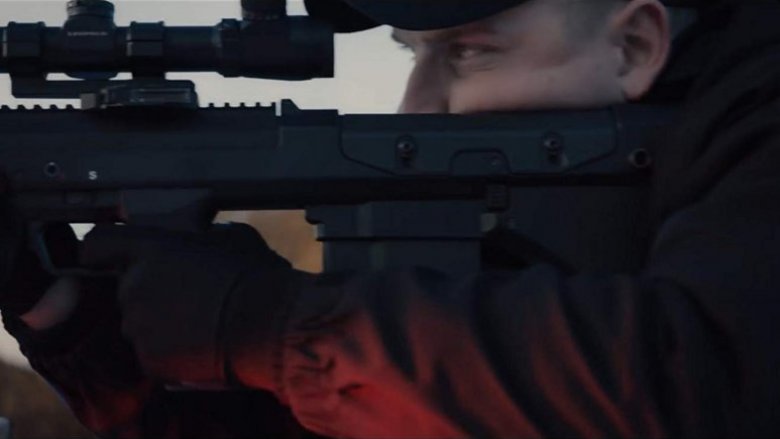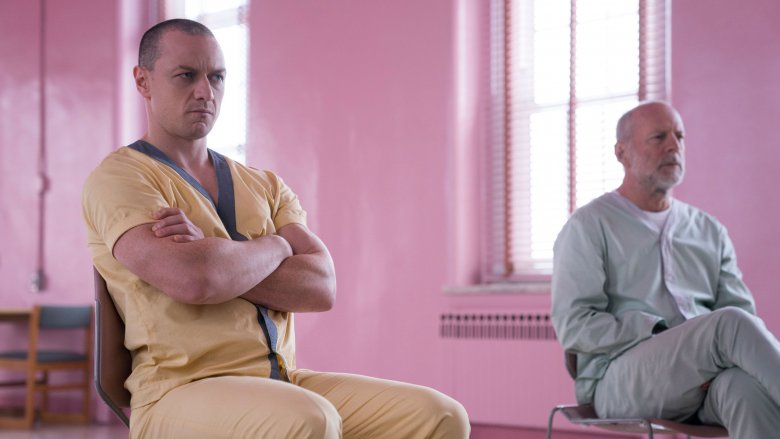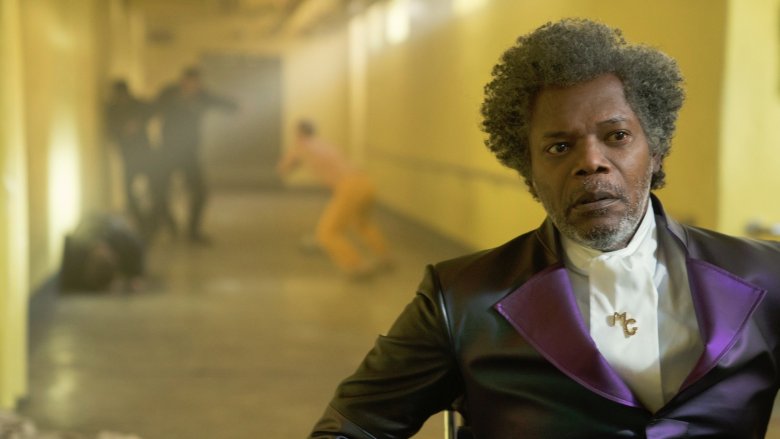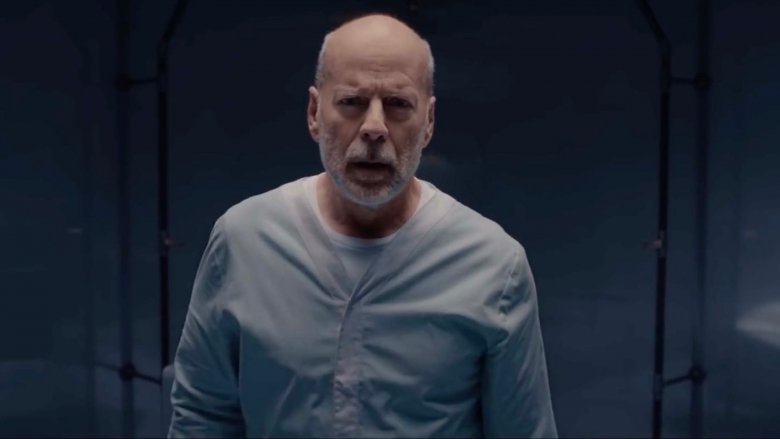The Epic Twist In Glass Finally Explained
As is typical for an M. Night Shyamalan movie, you may have left a showing of Glass scratching your head in confusion. Ever since The Sixth Sense, which also featured a brilliant performance from Bruce Willis, Shyamalan has been something of a narrative trickster. Using on-screen sleight of hand, he convinces audiences of one thing while secretly hiding the real twist up his sleeve, only to be revealed at the very end.
With this in mind, audiences may have already been looking for the secrets hidden in his latest film, Glass. Shyamalan upped the ante in this production and conjured not one, not two, but a mind-boggling three big twists to shock and surprise audiences. Glass is a film with many layers — layers that don't become apparent until after all the big revelations are made. But we're happy to pull them apart and make a deep examination of what makes the movie tick. What makes it so confusing? The film has received largely mixed reviews, and the twisty-turny ending might be to blame. What was the real twist in Glass? What does it mean? We're putting Glass under the magnifying glass to find out.
Shyamalan's history of twists
Director M. Night Shyamalan is the architect behind one of the greatest twists in film history. In the final moments of The Sixth Sense, it turns out that the protagonist, Dr. Malcolm Crowe (Bruce Willis), has been dead since the very first scene in the film. It doesn't get much more surprising than that, but Shyamalan couldn't shake his attachment to the art of surprise. In 2004's The Village, he again pulled the rug out from under the viewers' collective feet with the revelation that the film wasn't a period piece. The story actually takes place in a secluded village that shuns the ways of the modern world and invents monsters to keep people inside.
In short, his films make audiences suspicious of what seems obvious. "That's all I'm doing, is saying: 'You thought you were in the second act, or you think this is what's going to happen here' — because you're so cognizant of story structure. But then you realize you're in a different place than you thought — in a different story than you thought, sometimes. And that's fun by its nature," he explained in an interview with The Washington Post.
Shyamalan also said he had known for a long time that one of the films in the series that started with Unbreakable, followed by Split and Glass, would have to answer the question, "How come no one knows about this?" It fell to the twist he crafted for Glass to answer the question, in a surprising and complicated way.
Who Dr. Staple pretended to be
Dr. Ellie Staple (Sarah Paulson) has wide eyes that portray a constant look of earnestness. She's prim and proper, seemingly a rising star in the realm of abnormal psychology. She has a very precise specialization, she tells us in the very first trailer for the film. She is a psychiatrist who studies delusions of grandeur, specifically individuals who believe themselves to be superheroes. Worryingly, she also mentions that this is a growing field.
It seems so, considering that she gathers together three people with this belief: David Dunn, who has become "The Overseer," a vigilante with super strength; Kevin Wendell Crumb, who has dissociative identity disorder, one of his personalities being a supernatural entity known as "The Beast"; and finally, Elijah Price, a.k.a. "Mr. Glass," who possesses a diabolical, unmatched intellect. Dr. Staple's job is to get these men to let go of these "delusions" and realize that they are only human, not super at all. She does this by talking them through the apparent proof of their extraordinary abilities. Bars and bullets that Kevin took on were old and rusted. The Beast, able to climb up sheer walls, may have learned how from YouTube, according to his search history. David has irregularities in his frontal lobe that might be the reason behind his delusions. The Overseer's sixth sense of villainy might just be well-made deductions.
Dr. Staple's revelations shake them, leaving them to question if superheroes are real after all.
Who Dr. Staple really was
Here's the truth: superheroes do exist. Or at least, there are people — like The Beast, the Overseer, and Mr. Glass — who have extraordinary abilities that comic book fans would dub superpowers. In Glass, we don't have to wonder what it would be like in a world with superheroes. They walk among us... we just don't know it. Dr. Staple, if that's her real name, is just one of many people who keep this information from the public.
Mr. Glass suggests that there must be a reason as to why superhero comics were made. They had to have been based in some kind of truth. Sharp as ever, he realizes the truth that Dr. Staple has been hiding. All along, she's been well aware that the three patients in her charge are exceptional human beings. She's tried to convince them otherwise, however, in order to maintain the status quo. It's eventually revealed that Dr. Staple was part of a larger conspiracy, demarcated by clover tattoos, which keeps the world ignorant to the existence of super exceptional powers. Unable to brainwash them into thinking they were delusional, Dr. Staple is instead forced to kill Kevin, David, and Elijah to keep the truth from the world.
How to keep a secret with compassion
Sarah Paulson didn't know that her character would be central to an M. Night Shyamalan twist. In fact, she hadn't seen the script when she originally signed on to play Dr. Ellie Staple. Later, she wished that she hadn't seen the last five pages of the screenplay, because she then had to be constantly mindful of possibly foreshadowing her character's true role.
In an interview with Decider, Paulson said, "I looked to Night to guide me. The most important piece is that the audience not know — until they do. Anytime that it seemed like there might be a tiny bit of foreshadowing or a tell... he just really didn't want me to lean into those things. Anytime I did a take where he would say, 'I just felt a little bit like I knew your intentions were conflicted,' I'd be like 'Okay, let's do it again,' because he didn't want that. I do wonder if people who go back and watch the film again would notice those moments. It's very hard when you, the actor, have the information."
Paulson also said that she was able to play the duplicitous Dr. Staple so well because, at her core, the character believed she was doing the right thing. She wasn't a malicious character, she was compassionate — what she was doing was for the good of humanity. "That was his big word with me, 'Compassion, compassion, compassion.' Always wanting that to be at the forefront of her behavior, her motivation, and her choices."
What we thought the twist was
What some people don't know is that Glass is the final film of a trilogy. The series started with 2000's Unbreakable. In the film, David Dunn is the lone survivor of a train crash that claimed the lives of 131 people. Through this accident and prompting by a comic art dealer named Elijah Price, David discovers that he is impervious to harm, super strong, and can glimpse people's criminal past by touching them. The Shyamalan twist is that the train crash was orchestrated by Price, a.k.a. Mr. Glass, who wanted a superhero who embodied strength to match his supervillainy that was defined by his brittle bones.
Glass reiterates this, but with a twist. Kevin Crumb's father had also been on the train with the intention of getting psychiatric help for his son, who had started to exhibit symptoms of dissociative identity disorder because of his mother's abuse. The train crashed, killing him and leaving Kevin to amass multiple personalities that eventually came to form the Beast. Mr. Glass was inadvertently responsible for the creation of not one, but two superhumans. Learning of this, the Beast (which exists to protect Kevin) turns on Mr. Glass, giving him injuries that would later prove to be fatal.
What the actual twist was
Don't get comfortable just yet — Shyamalan isn't done with us. For those who are unfamiliar with the other two movies in the trilogy or don't think that Kevin's father's demise was a twisty enough curveball, worry not. The real twist, which has divided the internet and prompted this very article, has yet to be revealed.
At the end of the movie, the Beast and the Overseer face off in the superhero vs. supervillain showdown that Mr. Glass had wanted all along. This showdown is interrupted by at what at first appears to be the Philadelphia Police taking deadly measures. But these special forces answer directly to Dr. Staple, and all seem to have a clover tattoo on their hands. They are also acutely aware of both the Beast's and the Overseer's respective weaknesses, and take advantage of those to kill them. Before David dies drowning in a puddle, he touches Dr. Staple's hand, allowing him to glimpse the truth: she is actually a part of a huge, secret organization tasked with covering up the existence of superhumans. Having existed for thousands of years, the society has kept the knowledge of superhumans quiet through suppression and genocide. Having done her job successfully (although not without regret), Dr. Staple is ready to move on to the next case in the organization's continuing mission to keep "living gods" from ruling over men.
Wait... another twist?
If left there, Glass would have an infamously unhappy ending. Instead, its true ending embraces ambiguity and makes us wonder what happens next. All the characters are dead — David leaves behind his son Joseph, Elijah leaves his mother, and Kevin is survived by Casey, the protagonist of Split who managed to escape the Beast.
As we have learned from the film, Mr. Glass was always three steps ahead of everyone else. Though he may not have seen the exact circumstances of his death coming, he created a kind of failsafe so that his plan of exposing the existence of superhumans to the world would go through posthumously. Rather than a high publicity brawl at the top of the newly constructed Osaka Tower, Mr. Glass took security camera footage and live streamed it to a private server.
Footage of the Beast being beastly and the Overseer bending steel is sent to the survivors of the ordeal, who decide to release it. Such incredible videos quickly go viral, and Joseph, Casey, and Mrs. Price sit and watch as everyone and their mother start obsessing over the apparent existence of superheroes. Fade to black.
Possible sequels?
This ending raises the question: will there be sequels? Although Mr. Glass, the Overseer, and the Beast were certainly exceptional, they were never the only people like them. Why else would there have to be a huge clandestine conspiracy to cover up their existence? After the events at the psychiatric hospital, Dr. Staple is ready to move on to the next town to continue her work. What kind of superpowered people are waiting for her there? Does this trilogy secretly take place in the X-Men universe?
Probably not, but the thing is, we may never get to find out. It would be easy to speculate that now that the secret of superpowers is out, we'll get to see the wider world of exceptional people. M. Night Shyamalan, however, isn't so keen on continuing the series. In an interview with IGN, he said, "I want to make original movies and I want the audience to kind of finish the story in their head."
So as Samuel L. Jackson narrates the ending of Glass, telling the audience that the only thing that kept David Dunn from reaching his true potential was the belief that superpowers only existed in comic books, the Unbreakable trilogy draws to a definitive close. It took 19 years, but now the world finally knows the truth.
What is the Clover Organization?
Just what is the organization dedicated to keeping mankind in the dark about the existence of superpowers? The truth of it is... we don't really know. Calling them "The Clover Organization" is even something of a misnomer, because Shyamalan himself has said that this isn't even their name. He purposefully did not give the organization a name, but chose the clover to represent them because of its innocuous nature.
"I definitely didn't give the name intentionally, no name. But I picked the clover because it's everywhere, you know a three leaf clover, it's just innocuous and everywhere you look." he said in an interview with IGN, refusing to shed any light on the shady organization.
Here's what we do know. The society is thousands of years old and maintained by a diverse membership that likes to meet in public places, taking over entire restaurants. They have trained killers at their disposal, along with Dr. Staple's brand of Jedi mind tricks to convince superpowered people that they're delusional. The ruthless efficiency with which they dispatch superhumans suggests that they've dealt with worse before. We'll never know how many people have been convinced that they're crazy, or barring that, quietly killed to keep their powers a secret.
The internet reacts
Before even walking into the theater, people expected there to be some kind of classic M. Night Shyamalan twist to Glass. What they didn't expect was that the movie would be... unexceptional. The sequel follows up two widely well-received films, wrapping up the stories of three highly compelling characters in a lackluster way. Glass doesn't pull any punches, but the dispatching of David Dunn with death via puddle felt like a slap to the face.
The reviews for the film are largely mixed, citing a feeling of anti-climax and the weird way the film seemed to think that its audience was entirely unfamiliar with comic books and superheroes. It seemed that the triple-twist at the end of the third act wasn't worth the slow crawl of the first and second. Were people surprised? Yes. Were people satisfied? Not so much.
Some reviewers have even questioned how powerful the third and final twist really is. Will people believe in the footage or dismiss it as a hoax? Was this a good conclusion to such a long-gestating series? What we do know is that M. Night Shyamalan wasn't expecting the backlash and took it hard, breaking down before a TV appearance.
How we were kept distracted
M. Night Shyamalan kept the truth from us by convincing us that we already knew what was going to happen. The typical moviegoer is by now familiar with the structure of superhero films. Crossovers might start out slow, but they build into one final knock-down, drag-out fight for the ages. After getting an abbreviated version of that with the Overseer and the Beast in the first act, we were sure we'd get to see them complete their brawl in the final act.
Mr. Glass had even set the stage. Determined to show the world that there were truly exceptional people, the kind of stuff previously thought to only exist in comics, he needed publicity. From the start, the shining new Osaka Tower skyscraper had been mentioned on TV and in newspapers throughout the movie. Its unveiling would have thousands of people in attendance, all with cameras. Mr. Glass marked it so that Dr. Staple was sure that the Overseer and the Beast were headed there in order to have as many eyes as possible on them. But the aptly named "true marvel" of a tower was never visited. They never got off the hospital's grounds. It turned out that Osaka Tower was a towering red herring that we fell for hook, line, and sinker.
The little hints along the way
The details about Osaka Tower were only meant to distract audiences from Mr. Glass', and by extension the director's, true intentions. However, a second watch of Glass reveals that we weren't totally in the dark when it came to what the film was really trying to hint at. There were some very faint winks and nudges that Shyamalan placed to make the most suspicious of minds question what was really going on here.
First of all, the hospital's security cameras are repeatedly highlighted. The security system both serves to hinder and enable our main characters: it prevents them from moving freely, but also allows Mr. Glass to craft his own alibi. He is clearly adept at using the cameras, but Dr. Staple makes sure to delete all the footage of the revealing showdown on the lawn... or so she thinks. Mr. Glass has thought ahead and live streamed all the camera feeds as part of his master plan.
Another shady aspect of the film that doesn't quite fit was the hospital itself. At first, it seems to be empty save for our three main characters. Toward the end, we find out that there are plenty of other residents who have been conspicuously missing. Raven Hill Memorial doesn't seem equipped to handle three patients, let alone a few dozen. Where are all the staff? Maybe dismissed by Dr. Staple and replaced with members of her organization. Security isn't the point — it has always been about Dr. Staple's brainwashing "treatment."
